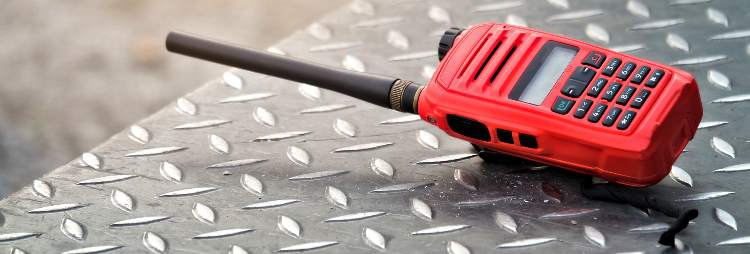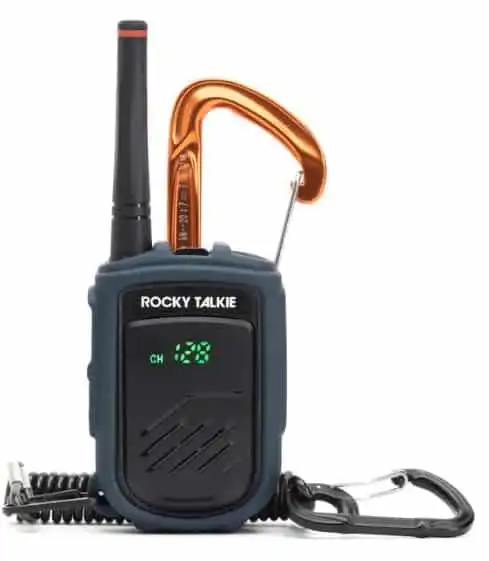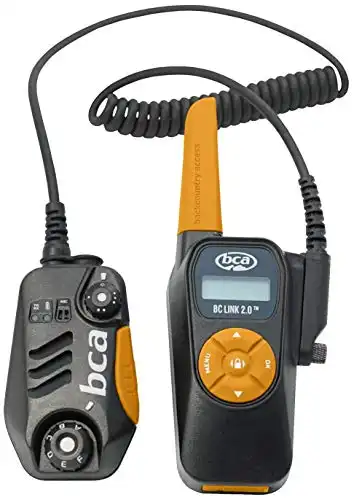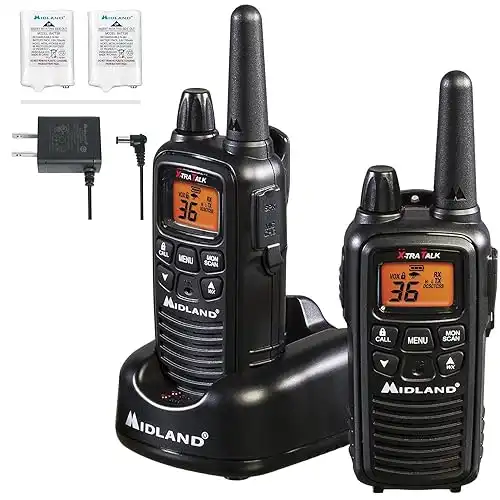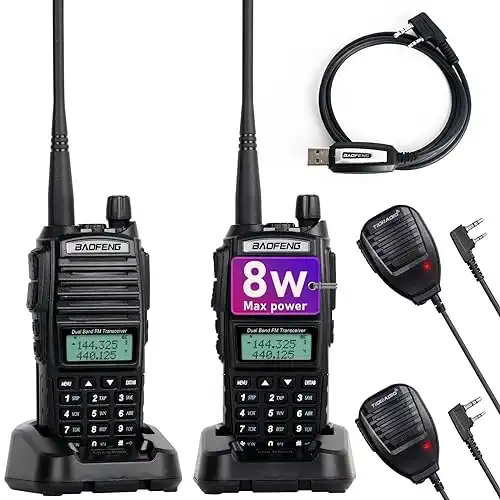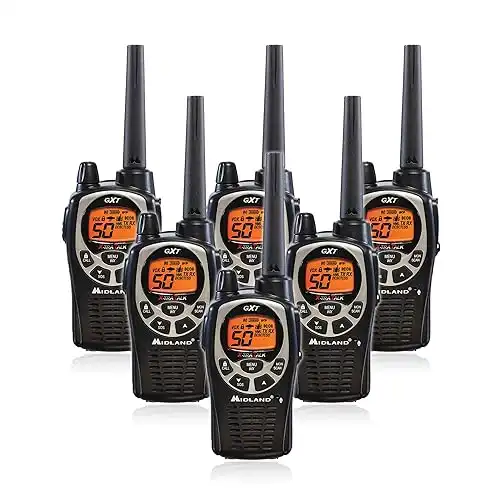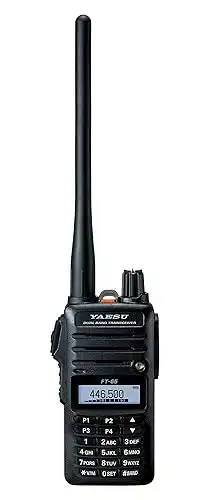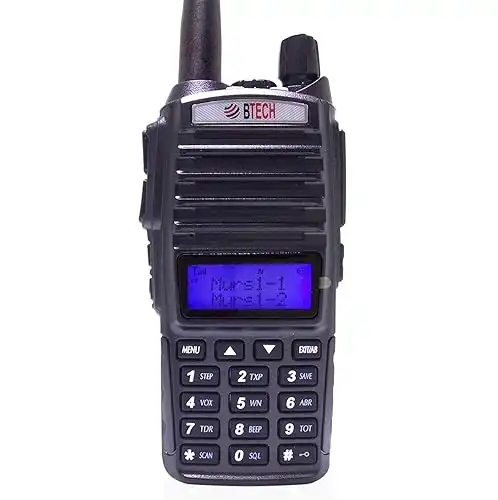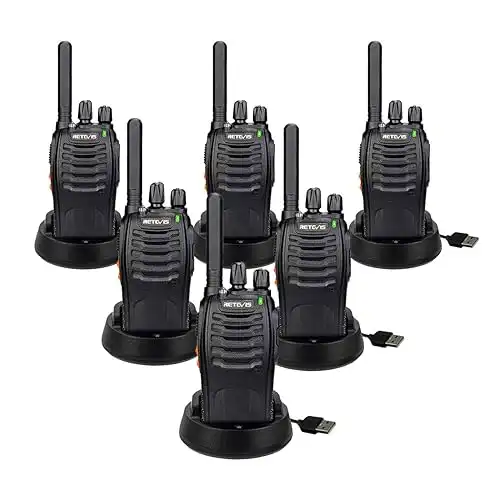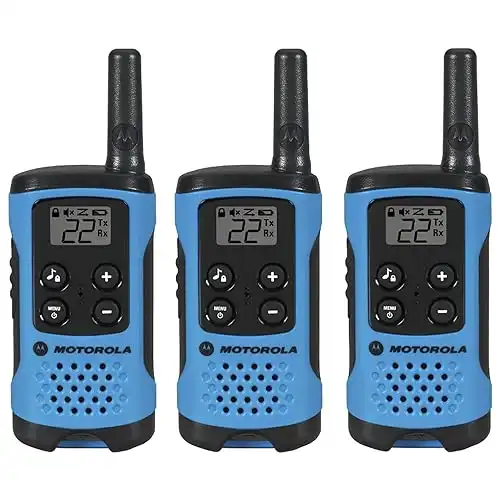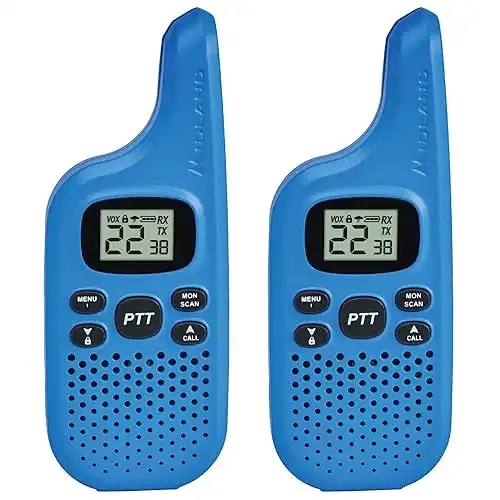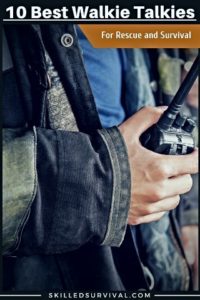
A Complete Guide To Finding & Using A Walkie Talkie For Communication
Because as a Mountain Rescue member, I’ve used dozens of walkie-talkie brands.
Each with its own Pros & Cons.
Some have extremely long ranges while others are known for their durability.
And no one wants to overpay for features you don’t need.
TOPICS IN THIS GUIDE… ↓(click to jump)
- Different Types Of Portable Radios
- The Best Walkie Talkie Features
- Best Walkie Talkies On The Market
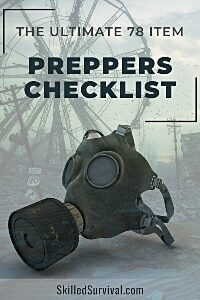
Want a free 78 item prepper checklist?
Click here to instantly download this Complete Checklist PDF. No purchase necessary.Different Types Of Portable Radios
There are LOTS of radios on the market today.
- From basic models with simple features…
- To professional setups for a worst-case emergency.
With such a wide range, learning the types is important.
The biggest difference is the frequency band in which they operate.
And thus, licensing requirements are different as well.
There are two major frequency branches:
- UHF frequencies
- VHF frequencies
↓ VHF Vs. UHF – What’s The Difference
1. UHF
UHF (Ultra High Frequency) radios.
UHF’s operate between 400 and 512 megahertz (MHz).
The FRS (Family Radio Service) radios fall within the UHF class.
FRS radios are available for personal and business use.
And require no FCC licensing.
That’s because power transmission is limited to a maximum of 0.5W.
The GMRS (General Mobile Radio Service) radios are also an example of a UHF radio class.
However, an FCC radio must be licensed to operate on GMRS frequencies.
This is due to the frequencies and extra transmission power (up to 5W).
Many consumer-grade UHF radios combine FRS and GMRS.
And this combination allows for greater flexibility.
UHF radios work well because the radio waves are shorter.
And shorter waves penetrate areas of interference.
They push through dense urban areas or forests.
Also, some UHF walkie-talkies can handle powerful antennas.
And in general, the more powerful the antenna, the further the transmission.
Examples of UHF Radios
The Best Walkie Talkies for Kids Use A Simple Design
For young kids, simple features and easy-to-use controls are best.
Fortunately, the ones built around this principle are often inexpensive.
And they tend to use standard AA batteries (or sometimes AAA).
They also feature large buttons and simple menus.
These features keep things from getting frustrating.
But their range is often limited.
Best Survival Walkie Talkies Are Rugged And Inexpensive
Once you outgrow the simple features, it’s time to find a sports model.
Lightweight, water-resistant radios with more channels.
And a range of up to 2 miles.
They’re commonly sold in packs of 2 to 4 , making it easy to outfit a family.
Best Long Range Walkie Talkies Use GMRS
What if your communication plans involve vehicle travel?
Then you’ll need long-range walkie-talkies.
Unlike FRS radios, these radios use the General Mobile Radio Service (GMRS) frequencies.
Thus, most can transmit a robust signal up to 20 miles (and some even 35 miles)!
Unfortunately, they’re more expensive.
This cost is due to the frequency range and higher-powered transmitter.
Plus, GMRS require an FCC license to operate.
Combined FRS/GMRS Radios
You may want the flexibility of a hybrid FRS/GMRS radio.
They allow you to bridge any frequency gaps.
2. VHF
VHF (Very High Frequency) radios operate between 136-174 MHz
The main advantage of a VHF walkie-talkie is more distance with less power.
How? VHF waves are longer.
VHF radios work best with a clear line of sight between sender and receiver.
That’s why VHF radios are used in aviation and marine communications.
Why? Because there are few obstacles on open bodies of water or the sky.
However, VHF band walkie-talkies can work great in open fields (farmers), golf courses, or other low-obstruction situations.
Examples of VHF Radios
MURS Walkie Talkies
Multi-Use Radio Service (MURS) are also available for business and personal use.
MURS are assigned 5 VHF frequencies (151.820, 151.880, 151.940, 154.570, 154.600).
And power is limited to a maximum of 2 watts.
No license is required, and there’s no age restriction.
These are not as popular as FRS or GMRS radios.
Hence, there are fewer models to choose from.
But MURS frequencies are not as crowded.
Thus, often offer more privacy.
Also, many MURS radios, such as the Motorola RMM2050, are designed for business use.
They’re rugged and durable.
MURS falls under Part 95 of the FCC rules.
HAM Radio Walkie Talkies
Amateur Radio Service (or “Ham Radio”) are for hobby and personal use.
Some amateur radios can operate on many UHF, VHF, and HF frequencies.
But the VHF frequencies are especially useful in amateur communications.
These are used extensively during search and rescue operations.
However, there’s a limit to the number of frequency bands available.
That’s why an FCC license is required to operate amateur radios.
There are three levels of licensing available.
These levels determine which bands and frequencies an amateur operator can legally access.

Want a free 78 item prepper checklist?
Click here to instantly download this Complete Checklist PDF. No purchase necessary.Best Walkie Talkie Features To Look For
Let’s say you’ve decided on the type.
How do you choose between the various models?
Here are some of the top features to consider:
Transmission Range
For many, range will be the most important feature.
Radios usually list their maximum range in the spec sheet.
But take it with a healthy dose of skepticism.
The “maximum range” is an estimate in perfect conditions.
We’re talking about:
- No atmospheric interference
- No obstructions
- And with fully charged batteries
In the field, this is hardly ever the case.
Buildings, trees, rainfall, or snow can interfere with transmission.
Be sure to plan for a reasonable margin of safety.
And choose one with a longer range than you “think” you’ll need.
When shopping for a long range walkie talkie, this is the most critical aspect.
Battery Life
Most portable radios run on various battery types.
From cheap AAs to rechargeable lithium-ion cells.
The listed battery life is also just an estimate:
- 90 percent in standby mode
- 5 percent reception time
- 5 percent transmission time
So, if you plan to talk a LOT, expect your battery to run down faster than this.
You’ll need more batteries in this situation.
Types & Number Of Channels
Depending on the type, you may have limited frequency options.
You may find other users on those frequencies in a crowded area, like:
- ski resorts
- construction sites
- first responders
- public transportation
- businesses
So finding privacy may be complicated.
However, some radios include privacy codes.
The bottom line is:
More frequencies (and privacy code) choices come at a premium price.
Additional Features
Keypad Lock
To prevent accidental channel changes, a keypad lock is wise.
It’s frustrating when frequencies switch in your pocket accidentally.
That’s how you MISS a crucial message.
Backlit Display
It’s never fun to fumble with buttons in the dark.
And you don’t want to turn on a headlamp every time.
A backlit display makes it easy to tell what you’re doing in the dark.
It’ll allow you to make quick adjustments, even at night.
Belt Clip
All portable radios made for outdoor and long-distance include a belt clip.
But not all belt clips are created equal.
If you plan to use the belt clip on your survival belt, tactical belt, or a plate carrier, make sure it’s up to the task.
Look for durable commercial-grade plastics and a strong spring mechanism.
Preset Keys
Speaking of “easier,”…
Preset keys store your favorite settings.
Preprogram your most-used frequencies and share them with the team.
That way, you can adapt at the push of a button!
Microphone, Earbud, Speaker Support
If you want to be hands free, look for one with an external mic, speaker, or earbud.
This prevents the need to raise the radio to your ear to hear or talk.
Thus, remaining discrete and hidden in evasion situations.
Weather Channels
Monitor the weather is critical for many missions.
So you’ll want a way to tap into the National Weather Service.
NOAA weather alerts will keep you on top of incoming storms.
Best Walkie Talkies On The Market Today
2 way radios are great for all sorts of activities.
- From fun family hikes to rescue missions
- From business communications to backyard BBQs
And everything in between…
That’s why you must find one that best matches YOUR situation.
So let’s go over the best-rated ones today.
And I’ll point out which are best for which activities:
This top-notch, license-free radio's been put to the test in the unforgiving Colorado Rockies.
It's ready for any situation where reliable communication is a must.
This radio features a specialized lithium-ion battery that boasts over four days of life.
Even in extreme cold temps -20°F!
The transmission power hits the maximum legal limit for unlicensed use, which is 2-watts.
This offers a potential range of over 25 miles (in optimal conditions).
In varied landscapes, you're more likely to experience a dependable range of 1 to 5 miles.
The Mountain Radio is also incredibly user-friendly.
It's ready to use straight out of the box with no complicated set-up required.
The controls are straightforward, with just five buttons, including privacy codes to keep your communications secure.
It also comes with a shatterproof LED screen and a robust thermoplastic covering to withstand the knocks and drops.
You won't find fragile clips here...
The Mountain Radio attaches securely with a sturdy carabiner and a back-up leash.
↓ Rockie Talkie Range Testing
This radio has 22 FRS/GMRS channels paired with 121 sub-channels.
This is essential for keeping your communications crisp and clear away from interference.
Power-wise, these units are locked in at 2 Watts for FRS, fully compliant with the latest FCC regulations.
This ensures you're using a device that's both powerful and legal.
When it comes to range, you're well-equipped.
Under most conditions, you'll get approximately 6 miles.
And under perfect line-of-sight conditions, these radios can reach up to about 40 miles.
For battery life you're looking at up to 400 hours of standby time.
This gives you the peace of mind your radio will be ready when you need it most.
↓ Review Of The BCA Radio
Our favorite walkie talkie is from Midland Corporation, which is USA based and established in 1959.
The Midland LXT600VP3 36-channel FRS radio is an excellent example of an entry-level FRS radio.
They're inexpensive and are ideal for outfitting an entire family for outdoor adventures.
The Midland LXT600VP3 can operate on the included battery pack or purchased AAA batteries.
So they can share batteries with other handheld electronics.
This is helpful because gear consolidation always reduces pack weight.
Best Uses: Hunting / Camping / Skiing / Most Outdoor Sports or Adventures
- Over 20 channels and 121 privacy codes help to block unwanted conversations.
- The Weather Scan feature monitors NOAA weather reports to update on hazardous conditions.
- The inexpensive price point allows you to purchase enough for a group.
- Over 20 channels and 121 privacy codes help to block unwanted conversations.
- The Weather Scan feature monitors NOAA weather reports to update on hazardous conditions.
- The inexpensive price point allows you to purchase enough for a group.
↓ Midland LXT600 Review
Starting in 2001, BaoFeng has become one of the major manufacturers of wireless communication equipment in China.
The BaoFeng UV-82HP radio is a great low-cost HAM radio with a wide range of features.
It features a high-power 8W transmitter, which helps to boost ranges reported by some users to over 10 miles!
Plus, the commercial-grade body can withstand the rigors of daily use and keep working.
A full-featured keypad allows you to program frequencies on the fly. But you can also load all the presets via a computer link cable and Baofeng’s software. This flexibility makes it easy to update settings and add the most used channels.
It's a full-featured HAM radio, which means that you'll need a license to use it!
Best Uses: Hunting / Camping / Skiing / Most Outdoor Sports or Adventures
PROS
- High/Med/Low power settings allow you to conserve battery
- Dual-band capability allows you to use both UHF or VHF frequencies to best suit the situation
- And the 128-channel presets can hold all your most frequently used settings
CONS
- Many features are worthless without an FCC amateur radio license
- Some users have reported difficulty in switching to 8W high power mode
↓ Baofeng UV-82HP Review
The Midland GXT 1000VP4 Set is perfect for all kinds of outdoor pursuits.
You can purchase them in standard packs of 2 or value packs of up to 12 units. Plus, there is a wide range of accessories to can add to each radio!
It comes with 50 channels and 142 privacy codes to keep your conversations secure.
It also features Midland's eVOX voice recognition technology. The tech allows for automatic transmission when the user speaks - without the need to press a button.
The GXT1000VP4 receives weather warnings and forecasts from the NOAA weather radio service. And it can also provide automatic audible weather alerts.
Best Uses: Hunting / Camping / Skiing / Most Outdoor Sports or Adventures
PROS
- Excellent battery performance and dual battery option
- Comes with both an A/C adapter and a car charger
- Automatic alerts for severe weather
- An extra headset allows for hands-free operation
CONS
- Advertised as waterproof, but the spec is only "splash proof"
- Rechargeable batteries lose efficacy over time, reducing useful operational life
- The range is dramatically less than the maximum range listed
↓ Midland Two-Way Radio GXT1000VP4
Motorola is one of the biggest names in small electronics devices.
The Motorola RMU series is ideal for communications in construction or business settings. Places where many groups all use similar radios and need simple, easy-to-use features.
The durable construction meets military specs for water, dust, and shock resistance. The powerful speaker makes it easy to hear radio traffic over background noise.
It operates on eight pre-programmed MURS frequencies. But it also includes 99 "business exclusive" frequencies and 219 privacy codes.
These all help to ensure secure transmissions and more reliable connections.
But these features come at a price, with the RMU2080D coming in near the top of our list.
Best Uses: Business Operations / Construction Sites / Factories / Warehouses
PROS
- Durable construction meets military specifications
- MURS frequencies are generally less busy than FRS/GMRS - this reduction in traffic helps to keep conversations clear and private
CONS
- There is no specification on "business exclusive" frequencies - so it may require additional licensing to use
- Frequencies must be pre-programmed - can not program in the field without a computer
↓ Motorola RMU2080D Radio Review
Yaesu isn't a household name in the US - yet...But their radios are gaining a good reputation in the amateur radio world.
The FT-65 is a great compact and durable ham radio with a full set of features.
And it's compact enough to fit in your pocket. It also features a tri-band transmitter capable of working on 144/440 MHz frequency bands.
With a full keypad, you can program in the field if needed. But it also includes a link to the program via computer software.
They house all this technology in a magnesium body that's waterproof up to 1m. So it’s more than just "splash resistant."
Best Uses: Hunting / Camping / Skiing / Most Outdoor Sports or Adventures
PROS
- Compact and durable
- Full feature keypad for field programming
- Great tech support from the company
CONS
- Complicated menu system
- Ergonomics of button layout not the best on small form factor body
↓ Yaesu VS-6R: One-Year Review
The BTECH MURS-V1 is a solidly built radio that features the MURS frequency band. This feature means it’s capable of transmitting further in open areas than FRS radios.
It also comes pre-programmed with three banks of 5 MURS channels. Including unique privacy codes for each bank.
Each bank can be field-programmed with the keypad menu system.
Voice-activated and scanning modes make this radio more capable than most. And features like a built-in flashlight and AM/FM radio add extra versatility.
You can even monitor two incoming frequencies at once with independent push-to-talk buttons.
Best Uses: Hunting / Camping / Skiing / Most Outdoor Sports or Adventures
PROS
- MURS frequencies give more privacy and better range
- Dual-channel mode allows you to keep track of two different conversations
CONS
- Power adapters seem to be missing QC steps, occasionally needing returns/replacements
- Wear issues on volume adjustment can make control difficult after prolonged use
↓ Suggested Radios For Outdoor Activities
Since 2008, RETEVIS has been serving the radio needs of different consumers from general personal users, commercial users to amateur users.
The Retevis H-777 radios are not as rugged as some other walkie talkies. But they are economical and practical.
They feature a large-capacity battery that recharges via USB. USB recharging allows you to use external battery banks or solar chargers when you're low on power.
They work with all other FRS/GMRS radios and can support the same channels and privacy codes.
Unlike similar radios, the Retevis appears to work well in indoor settings. So they may be the right solution for warehouses and other steel structures, as well as outdoors.
Like all radios, the listed maximum range is difficult to achieve. But they tend to perform well in forested and mountainous terrain.
Best Uses: Business Operations / Construction Sites / Most Outdoor Sports or Adventures
PROS
- Inexpensive
- Performs well indoors and in steel structures (which usually reflect radio waves)
- Compatibility with other radio models is excellent
CONS
- Some users do not like the ~1-second delay on pushing transmit before the channel is open.
- The range is less than advertised
- Durability isn't up to heavy daily use
↓ Retevis H777 Review
The Motorola Talkabout Series is perfect for keeping in touch with a young family during any outdoor adventure.
They're inexpensive, feature easy-to-use controls, and a bright LCD screen.
A keypad lock prevents accidental changes to the settings. And a flashing low battery alert draws your attention before you run out of juice entirely.
Best Uses: Great For Families with Young Kids (local events/backyard fun)
PROS
- Compatible with all FRS radios
- Runs on 3AAA batteries for easy replacement
- Effective range out to 5 miles (16 miles maximum listed range)
CONS
- The battery compartment is difficult to open
- Indoor use can dramatically reduce the overall range
The Midland X-Talker is another excellent option for those with kids. The Midland X-Talker has kid-friendly controls and incorporates colors that kids love.
It utilizes the FRS frequencies and requires no licensing to use.
These are not high-powered radios. So don't expect long-distance communication from them. But they work great for around the yard and in the house.
They can help teach children how to use a radio before you move on to more powerful (and expensive) options.
Best Uses: Great For Families with Young Kids (local events/backyard fun)
PROS
- Inexpensive
- Lightweight and compact
- Simple kid-friendly controls
CONS
- The range is generally less than a mile
- Battery life is only 1-2 days, especially if left on continuously
- No ability to charge batteries internally; you must remove them for charging
Final Thoughts
When cell service fades, your communicate does NOT have to follow suit.
At a bare minimum, get a hand crank radio.
But it’s not enough for those serious about their comms.
The bottom line is:
You need a direct two-way radio plan with your family and team.
And there are plenty of handheld long range walkie talkies available today.
Why Trust Skilled Survival...
Go here now to review a full breakdown of:
- Who We Are
- Our Credentials
- Our Mission
- & Product Recommendations...
Here are a few highlights of our teams credentials & certifications:
- Certified Member of a Mountain Search & Rescue Organization
- Plant Emergency & Safety Leader for a Major Food Manufacturer
- Member of the 10TH Mountain Division Hut Association
- Certifications: Avalanche 1, WFR, CPR
- Official Gear Tester for Numerous Outdoor Gear Companies
- Countless Multiday Backpacking trips into Remote Wilderness
- Bachelor's Degree In Mechanical Engineering
- Bachelor's Degree In Civil Engineering
- Bachelor's Degree In Biomedical Engineering
"It takes 20 years to build a reputation and five minutes to ruin it." - Warren Buffett
We're fully aware that TRUST is NOT something you GET but is EARNED.
And we'll continue to earn YOUR trust through our forthright and honest approach with each new Blog Post, Guide & Product we create...
Jason K.
P.s. Do You Live In A 'Danger Zone' County?
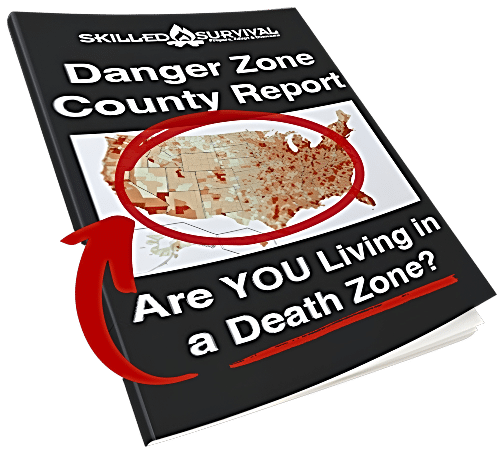
Find out now using my Danger Zone County List & Special Report it’s absolutely FREE.
In minutes you’ll know EXACTLY where you stand and if you should be worried or not..
So click here to get my FREE Danger Zone County List & Report…
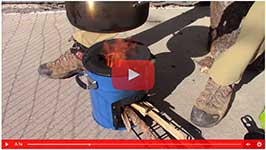
Recommended Reading
Best Cell Phone Signal Boosters & Do They Really Work?
Dealing with weak cell signal? You need a cell phone booster and we'll show you the best ones to buy to solve your problem once and for all.
Best Tactical Boots That Can Handle The Most Brutal Terrain
Not all boots are created equal and if you want the best, you have to go tactical. We review the best tactical boots on the market today.
Best Tactical Belts (& Setups) For Extreme Combat
The best tactical belts are innovative, versatile, durable and 100% worth wearing! In this guide, we review the best ones on the market to make your search easy.
Best Folding Saws To Easily Pruning Or Clear Massive Brush
The best folding saws are sharp, durable, compact and 100% worth owning! In this guide, we review the best ones on the market to make your search easy.
Best Headlamps Experts Trust For Hunting, Hiking & Survival
Not all illumination is created equal, some options are great, but many are a waste. I show you the best headlamps and key features you want.
Best Tactical Gloves For The Most Unforgiving Tasks
Not all gloves are created equal. A few are excellent, while many are rubbish. We show you the best tactical gloves and features to look for.

